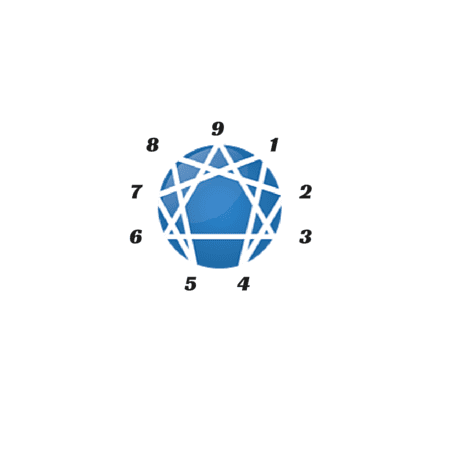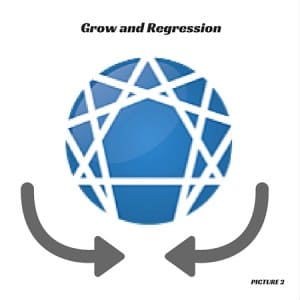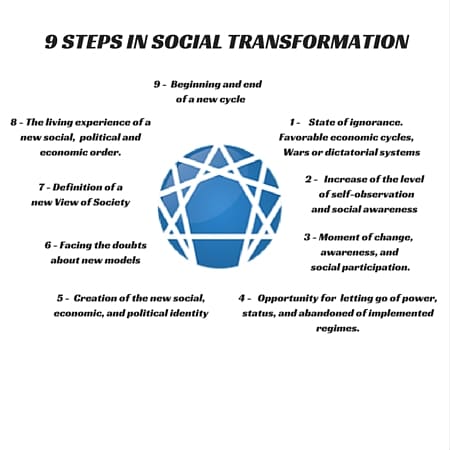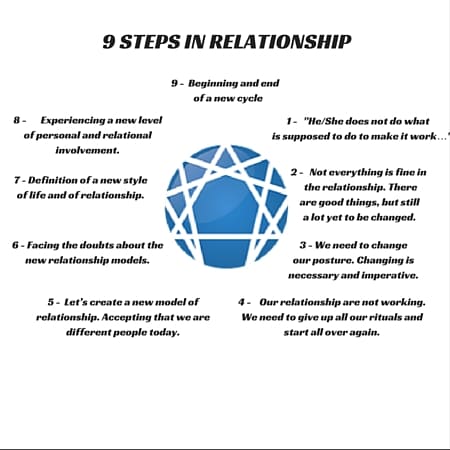
About the Methodology
The Enneagram is a wisdom of symbols. Understanding its symbols is having a new insight about our human condition. Through the ages, the symbol of the Enneagram has been the target of complementary understandings and insights.
In this 9-Step Enneacoaching methodology, an interpretation of the movements and stations of the Enneagram symbol is made. This interpretation is based on the dynamics of the Enneagram symbol as well as a search for the perception of our transformation. This is a path for conscious growth where each will travel as the transformation evolves.
The stations or points and their movements, as we understand them within the scope of this dynamics of transformation, are not the same as those used in the Enneagram of the Personality. It is essential that we temporarily forget that perception so that we can better understand this 9-step model.
Concept of stations and steps
For the purposes of this methodology, we use the terms ‘stations’ or ‘points’ and ‘steps’. Each of these terms symbolize different things and it is essential that we understand them up front. The stations or points are represented by the 9 points described on the diagram of the Enneagram. The 9 steps of our program, on the other hand, represent the motion between each one of these stations or points. In other words, when you move from station 9 to station 1, you are taking the first of the 9 steps of the methodology.
The symbol:
As we had already mentioned, the symbol is comprised of 9 points or stations, an external circle, and the internal connecting lines between each of the numbers.
Each of the nine points or stations and some internal links have a very specific meaning.
For instance, in our 9-step method the link from point 4 to points 1 and 2 respectively (see picture 1) is essential for us to understand the risks associated with our growth pathway. In particular it is essential to understand why so often we experience some very deep changes and then, all of a sudden, we give them up and go back to our initial point, or behavior. Later on, we will discuss this issue further in detail.

On the other hand, the circle that circumscribes the symbol represents our evolutionary pathway, as if it were a road we walked on toward our growth for a specific transformation moment. In other words, if we are in station 2 and move to station 3, we advance in our level of growth and we are closer to our transformation.; and we go backwards when we move back to station 1. Each of these movements of progression represent one of the 9 steps.
In our 9-step methodology, we navigate through the symbol in its two domains. The inner links (internal motion), represented by the inner links between the numbers and the outer links (circular motion) represent the sequence of numbers connected by the external circle of the Enneagram.
Circular Motion
Concept of growth and regression
Two different forces work simultaneously throughout our work and throughout any level of growth or transformation – the force of growth and the force of regression (Picture 2). These two forces work in opposite directions. The growth force works clockwise, and the regression force, counterclockwise. Progression will take place when your will is stronger than the opposing force.
It is like a sphere thrown counterclockwise. When this ball is thrown from point 9 toward point 1, it gains more and more strength and speed. Comparatively, the impact exerted on stations 1 and 2 is exponentially greater than that which is exerted on points 8 or 7. It is as though this ball kept gaining more and more propulsion, increasing its speed and energy. As it gets to the farthest seasons, it reaches its greatest impact energy. This is one of the reasons why the beginning of growth and transformation processes is substantially more demanding than when they are already in motion.
Likewise, we have inside of us an energy that pulls us clockwise toward the evolutive pole, and that moves us to change and grow. It is equivalent to the strength each one of us manifests when we are children and decide to learn how to walk. Even though the challenges are great, children feel an uncontrollable energy to make these efforts, against all their natural limitations. Their only focus is reaching the objectives that up until now had been out of grasp by means of their own will and freedom. To accomplish it, children have to challenge their own limitations, they have to keep their body balance and walk. Human growth and behavior transformation is just like this. When our growth energies are focused, we begin to have freedom to choose fighting against this involutive force and start growing.
Stations 9, 3 and 6, symbolized by the intenal triangle, will be specific seasons of shock. We will describe them more thoroughly when we study them more deeply.

Nine Steps and nine Stations
As we move through the 9 stations and the 9 steps, we are traveling through the process of growth. The steps are the mechanisms that make it easy for us not to get stagnant or not regress in the stations that support the fulfillment of the cycle of growth.
Station 9 – Balance and forgetfulness. First shock point.
All of the transformation processes have their beginning and end in season or point 9. At this point, we have what we call the end and the beginning of a new scale of growth – a new scale of growth that begins and a past scale of growth that finishes. When we study personality Type 9 in the Enneagram of Personality, we understand two essential facets that can help us to figure out this moment a little better. The first is the difficulty that this personality type has to begin a new cycle of action, and a concern to maintain a certain level of stability. Furthermore, there is the pursuit of an unreachable state of balance since everything that surrounds it is always in motion. A second essential aspect that we can point out is its forgetfulness of itself, represented in the personality by the forgetting of ones own priorities.
In our map of transformation translated by the 9 steps, the forgetting of something leads to the need for committing. The choice is one of deciding to be a machine rather than being nothing. At this point, our first step takes place.
In this point 9, all of us, somehow or another, forget the growth we have achieved. And this forgetfulness leads us to a new stage of “ignorance”, integrating the previous growth but forgetting that we have been experiencing dynamic growth. In order to understand this phenomenon better, try to see the symbol of the Enneagram – Picture 1, as if it were a figure in three dimensions. Whenever we start from point nine and begin toward points one, two, three, four and so on up to point eight, we are experiencing a dynamic of growth. Station 9 symbolizes the end of this dynamic and the beginning of a new one. It’s like a landing stairs that you achieved. The dynamic motion coming from behind is materialized in station 9, and it simultaneously begins a new cycle.
In station 9 the first shock to our progress takes place. A shock of forgetfulness of the way we had been walking. It happens just like a flashlight that makes us forget and fall asleep. It is like a warrior who comes back home after a battle and decides to rest. During his rest, he falls into a light “sleep” and dozes off. At this point our new pathway of transformation also begins.
Step 1 – The Passage from “Balance” and from Forgetfulness to the Automatism of the Man-Machine
We cannot remain forever in this moment of shock. Therefore, it is imperative that we advance toward the next point or station. Each one of these 9 steps are stages of awareness and understanding for a specific transformation. Many people get narcotized by dreams and desires without ever making real progress. The world of dreams and idealization makes them forget “real” life and does not allow them to advance. The 9-step methodology will not let us fall asleep in any of these seasons.
Station 1 – The Man-Machine
At this point, we begin the work on growth. This is the beginning of a growth trip that leads to a new experience of “Being”.
In this station, we react automatically and uncontrollably toward a particular aspect we are seeking to improve. We do not have the essential awareness needed for a new stage of growth. Here everything surrounding us influences us as if we were a machine that does not have the power to make decisions. We do not always understand the limits between others and ourselves. We cannot understand that we do not decide anything and that everything happens by chance. Usually we justify that with excess of work or by the necessity to fulfill basic necessaries.
Step 2 – The Passage from the Man-Machine to the Observing Self
For the first time, we challenge ourselves to look at our own behaviors. This is an essential step that will help increase our understanding of ourselves from the perspective of the observer of the machine s/he himself operates, without any control over oneself – the Man-Machine. Observation will be our most important tool at this stage.
Station 2 – The Observing Self
At this point, we are a self who observes ourselves. We see good things and not so good things about our growth. Without observing ourselves from different perspective, we will never get to know who we are. Many of us are addicted to looking at ourselves as if we were too good; others to looking at themselves as if they were too bad; and still others to not looking at themselves completely. Any of these addictions will not allow us to advance from this station and a regression will be inevitable. We need to develop recognition. Without it, it becomes impossible to grow. Recognizing implies not judging. Only at this moment will we be ready for our 3rd step.
Step 3 – The Passage from the Observing Self to the Availability for the Shock
In some moments of our growth, we have to wait for something to happen. In order for us to be available for this step, we must manage to find the best and the worst in ourselves in the previous stage, without judgement and with recurring observation.
Station 3 – Emotional Shock
We are formatted to live in a world of duality. A world where one effect is generated by a cause, where A generates B. In our growth, as well as in so many areas of our life, we already understand that the transformation occurs when there are three forces at work, positive energy, negative energy and neutralizing energy. Father, mother and the son. In the sciences, with protons, electrons and neutrons or the active force, the negative force and the neutralizing force. In this season, we understand that, between the good there is in us, and the evil there is in us, there must grow an emotional force that shall propel something to happen. This force shall arise (as a third force) in a given moment when we are ready. At this moment, our internal dialog goes like this: “It is today! I will do it differently”. An internal motivation comes and a Will to move forward like never before.
Step 4 – The Passage from the Emotional Shock to the Authentic Deconstructed
We are getting closer and closer to reaching our moment of transformation. This new stage comprehends a new self. We will not be ready for it until we recognize our present self. This is the passage which gets us closer to whom we truly pretend we are or closer to whom we are not.
In this step, the shock occurs when we cannot look at ourselves with criticism or vanity. Only at this moment, do we allow for the entry of a third force or will. This is a moment for us to wait for the signs that come from the outer world and inner world. At this stage we will be able to understand our emotional energy for change. It is a time for us to listen and to feel. It is a moment for the deepest motivation to arise. It is a moment for us to listen to our being. Outer signs and inner signs are what we need for our next move and for us to access our strongest motivation for change.
Station 4 – Deconstructed Self
At this point, we enter the most deconstructive phase of our journey. We can only fill up a glass if it is empty. Our goal here is to let our glass leak. In order to accomplish it, we will have to develop the capacity to leave behind that which will not really be essential to our journey, without attachments. This is a decisive moment. It is here where an important moment of our walk or journey takes place. If we look carefully at the diagram of the Enneagram, we will understand that the symbol represents a certain depth and there is perfect symmetry between one side and the other of the diagram. It is here where everything is decided and where we start a point of no return.
Step 5 – The Passage from the Deconstructed Self to the Constructed Self
This is the crucial passage. It is at this point that we will have our transformation “second”. I call this stage between point 4 and point 5, the “Zone”. This second represents our moment of deliverance and the passage to the other side of the diagram. With this passage, we enter our creation and let go of our Addicted Self. Any man who goes past this point will never go backward in his specific transformation growth. As you will notice, any regression to earlier stages that takes place at this point (regression to station 1 or station 2) occurs with emotional impulses trying to pursuit apparent “security”. Moving forward transformation takes place. This is the moment we shout from within ourselves, “Enough! I will never be the same again!”. This is the step of getting rid of the attachments to our old self, and the enthusiastic pursuit of building our new self. Many growth processes ignore this whole pathway that leads to this point, skipping crucial stages of the journey. Such change is doomed to failure. Only after we have let go of our prisons, we can recreate freedom.
Station 5 – New Self Constructed
We are now ready to re-create ourselves. Our cup is finally empty. It is time to fill it up. We have reached a point from where we can start redesigning our new Life and our new Self. It is a time for us to enthusiastically imagine what we want to be. We have come halfway in our transformation program, and we have already found out a lot and deconstructed old self. Now, it is essential that we choose our new Self.
Step 6 – The Passage from the Constructed Self to the Mental Shock
Every growth process, if we consider it as a cycle, has a beginning, a middle, and an end. In this methodology they are symbolized by the shock points. We had the beginning of our growth in shock point 3. Only after this point, we moved from our observation to deconstruction. Our second moment of the cycle represents the middle the way, and it is symbolized by point 6, the shock of will. We are ready for this step when we define ourselves. The next step is aimed at facing the unknown, as well as at understanding that something we have idealized will have to go through the filter of courage and of faith in ourselves. I’m I this new self or am I cheat on me?
Station 6 – Mental Shock
At this point, the outer world and inner believes tests our determination. In this season, a lot of uncertainties arise, seeking certainty. This is the time for us to make use of our awareness and courage. The will to go ahead only comes with the awareness of ourselves, and of our pathway. The outer world intervenes as a test for our determination. It is time for us to understand the strength that lies within ourselves. Only this strength can overcome the impact coming from the outer world and our inner believes.
Step 7 – The Passage from the Mental shock to the Visionary Self
Our plan develops our unshakable faith in the fact that we deserve to be who we authentically are, and that we are ready to make the dimensions of our self and of our dreams grow. Once we have resolved our doubts about our worthiness, and about the impact of the outer world, it is time for us to imagine all of the results of our new way of being.
Station 7 – My New Visionary Self
It is time now for our dreams and idealizations to take new wings. It is time for us to turn our definitions into an imagined reality. At this point, imagination and idealization get mixed up in a fusion between the desire and the awareness of who we are (defined in point 5). The image is experienced with enthusiasm and spontaneity. Ideas take on a new form by the concrete definition of what is intended to be materialized. Only at this point we should start to set our true goals.
Step 8 – The Passage from the Visionary Self to the Materialized Self
The image floods our perception, propelling the materialization. Nothing can be kept forever in our imagination, especially after the long journey we have made, and the challenges we have overcome. Action is the only way.
Station 8 – My New Materialized Self
It is time to act as we create. The work has been created, and now it is time for it to be lived. In this season the plan that had been designed by the architect (point 5) comes true; the “house” that had been decorated by the designer (in point 7) needs to be lived in. The house needs to be lived in by the one who has struggled with integrity in each of these phases. Now, that which is defined needs to be accomplished. In this phase, we are experiencing a time we had longed for as a fantastic dream come true (with a certain need for growth).
Step 9 – The Passage from the Materialized Self to the Balance and Forgetfulness Shock
Every accomplished process generates comfort. The comfort of us being who we feel we ought to be. When the learning is accomplished, confidence breeds spontaneity. We are ready for a new cycle of growth. As a general rule, before a new beginning, we are ready for a recovery “sleep”.
Station 9 – Balance and Forgetfulness – First Shock Point
A new cycle of growth is about to begin, provided we forget we have just finished a journey. Since this journey was carried out while awake, this point will be a point for recollection and learning.
Internal Motion
Regressive Internal Moves
In addition to the regressive moves throughout the circle of growth (for instance, from station 2 to station 1, or from station 3 to 2), there are regressive shortcuts that make us go backward in our growth. As a rule, these moves are more abrupt and imperceptible if we are not aware and awake in our process of transformation. These moves are at the basis of so many repeated and wasted efforts in the growth processes. When they are misunderstood, they can produce stimuli of discouragement and unbelief that so many times restrict new attempts. This 9-step methodology allows us to keep track of our temptations at every moment. Only awareness enables us to escape from such sophisticated traps.
Move from Station 4 to Station 1 or Station 2
When we are in our transformation process and reach point four, we come across our Deconstructed Self. Our Ego understands our sincere intentions to empty the glass so that it can be filled up again. It is necessary to let go of things that do not work. Accepting and letting go of our “addictions” means to eliminate a few addictions. Addictions that provide us with a false sense of security. The fear of losing this sense of this apparent security, and throwing away the masks of our deluded self, leads us to get in touch to our deepest fears. The reaction is immediate and mechanized; escape becomes an apparent solution. Before this compulsion, the concentrated energy necessary for a definite change disperses and flows toward its natural path. The link to stations 1 and 2 manifests an inevitable escape. The whole process of deepening and growth developed up to point 4 is ignored now, and it is expressed in diferente forms in the imminent stations 1 and 2.
In station 1, we manifest the uncontrolled mechanization of our behaviors, and ignore how far we have come, as well as the present contact with our true wounds. Now everything seems uncontrolled again. The reaction is mechanical and not conscious. An apparent relief takes place and the growth ceases. The mechanized behavior replaces the doubt and the uncertainty. At the moment, it seems to be a proper and soothing decision. In the move toward station 2 the Self gives up the “work” to go back and observe. All of a sudden, that which seemed to be so bad becomes a conscious mixture of observation between positive aspects and less positive aspects. The quick escape heals the open wounds but compromises the growth journey. New phases will have to be covered again so that we can resume the stage we have recently given up. In my Coaching practice, it is very common for clients to report how many times they have tried to go through processes of change with relative effort and engagement, but got caught in this trap. It is distressing to see their despair when I talk to them about the 9 steps and they realize how close they had been to a sustainable change, but ended up leaving the “zone”.
Move from Station 7 and Station 8 to Station 5
After having gone past the “tunnel” passage (the passage from station 4 to station 5), it is no longer possible to go back. If we fulfill the necessary steps, the relapses that might eventually occur shall never be bound to take us to the previous level of consciousness (stations 4 and below). The impulsive moves are easier to be processed by our consciousness and to be resumed. At point 7, when the images get vivid and the projects are idealized, they sometimes do not correspond to our deepest personal standards that we have nevertheless designed. It is time for our architect to start drawing again and revising some criteria. Our new Self needs to be recreated somehow. This move characterizes the internal regression from point 7 to point 5 drawn in the diagram. (see picture 1).
After passing station 4 to station 5, the return is no longer possible. If we fulfill the necessary steps, the setback will never be marked by the previous level of consciousness (stations 4 and below) . Impulsive moves are easier to be made aware and resumed (movements from station 7 and station 7 to station 5).
In station 8, the same thing can happen. All of a sudden, when we are living according to our plan, we may feel the need to redefine it. After each of these regressions, we will need to resume our march. We always do the same thing as of station 5, with the recreation of our constructed self. Just as this map of transformation is manifest in human transformation, the same occurs in different areas of transformation, specially in relationships, political alterations and business areas. I will be leaving bellow three diagrams with examples of transformation in the areas of business, social changes and interpersonal relationships.
NOTE: Besides having been applied in detail in our Enneacoaching certification program, this work was published in the book entitled 40 Days and 1 Second To Change Your Life – Editora Topbooks (Topbooks Publishing House) – Portuguese version, 2014
Translation from Portuguese to English by Peter Esteves and Wesley Cavalheiro
Eduardo Reis Torgal – eduardo.torgal@eneacoaching.com – www.eneacoaching.com +351 915335514 Founder of Eneacoaching Institute in Portugal. Business Master Coach by Behavior Coaching School. Practitioner in NLP e International Master Trainer in Coaching. Business Coach since 2004 in Portugal and Brasil. Vice – President of IEA Portugal Association. Enneagram professor and supervisor (in Portugal and Brasil) by the EPTP – Enneagram Professional Training Program. IEA Accredited Professional
ENNEACOACHING 9 STEPS – IN ORGANIZATIONS

ENNEACOACHING 9 STEPS – IN SOCIAL TRANSFORMATIONS
 ENNEACOACHING 9 STEPS – IN INTERPERSONAL RELATIONSHIPS
ENNEACOACHING 9 STEPS – IN INTERPERSONAL RELATIONSHIPS


